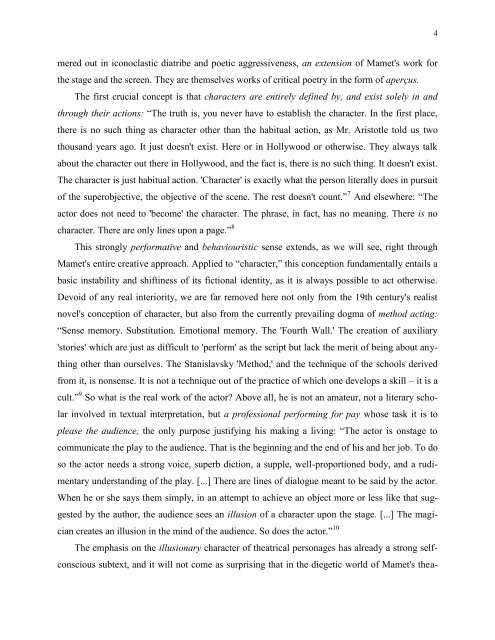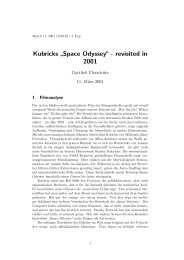Henry M. Taylor, 'Frames, Cons, and Double-Crosses - Cinetext
Henry M. Taylor, 'Frames, Cons, and Double-Crosses - Cinetext
Henry M. Taylor, 'Frames, Cons, and Double-Crosses - Cinetext
You also want an ePaper? Increase the reach of your titles
YUMPU automatically turns print PDFs into web optimized ePapers that Google loves.
mered out in iconoclastic diatribe <strong>and</strong> poetic aggressiveness, an extension of Mamet's work for<br />
the stage <strong>and</strong> the screen. They are themselves works of critical poetry in the form of aperçus.<br />
The first crucial concept is that characters are entirely defined by, <strong>and</strong> exist solely in <strong>and</strong><br />
through their actions: ―The truth is, you never have to establish the character. In the first place,<br />
there is no such thing as character other than the habitual action, as Mr. Aristotle told us two<br />
thous<strong>and</strong> years ago. It just doesn't exist. Here or in Hollywood or otherwise. They always talk<br />
about the character out there in Hollywood, <strong>and</strong> the fact is, there is no such thing. It doesn't exist.<br />
The character is just habitual action. 'Character' is exactly what the person literally does in pursuit<br />
of the superobjective, the objective of the scene. The rest doesn't count.‖ 7 And elsewhere: ―The<br />
actor does not need to 'become' the character. The phrase, in fact, has no meaning. There is no<br />
character. There are only lines upon a page.‖ 8<br />
This strongly performative <strong>and</strong> behaviouristic sense extends, as we will see, right through<br />
Mamet's entire creative approach. Applied to ―character,‖ this conception fundamentally entails a<br />
basic instability <strong>and</strong> shiftiness of its fictional identity, as it is always possible to act otherwise.<br />
Devoid of any real interiority, we are far removed here not only from the 19th century's realist<br />
novel's conception of character, but also from the currently prevailing dogma of method acting:<br />
―Sense memory. Substitution. Emotional memory. The 'Fourth Wall.' The creation of auxiliary<br />
'stories' which are just as difficult to 'perform' as the script but lack the merit of being about any-<br />
thing other than ourselves. The Stanislavsky 'Method,' <strong>and</strong> the technique of the schools derived<br />
from it, is nonsense. It is not a technique out of the practice of which one develops a skill – it is a<br />
cult.‖ 9 So what is the real work of the actor? Above all, he is not an amateur, not a literary scho-<br />
lar involved in textual interpretation, but a professional performing for pay whose task it is to<br />
please the audience, the only purpose justifying his making a living: ―The actor is onstage to<br />
communicate the play to the audience. That is the beginning <strong>and</strong> the end of his <strong>and</strong> her job. To do<br />
so the actor needs a strong voice, superb diction, a supple, well-proportioned body, <strong>and</strong> a rudi-<br />
mentary underst<strong>and</strong>ing of the play. [...] There are lines of dialogue meant to be said by the actor.<br />
When he or she says them simply, in an attempt to achieve an object more or less like that sug-<br />
gested by the author, the audience sees an illusion of a character upon the stage. [...] The magi-<br />
cian creates an illusion in the mind of the audience. So does the actor.‖ 10<br />
The emphasis on the illusionary character of theatrical personages has already a strong self-<br />
conscious subtext, <strong>and</strong> it will not come as surprising that in the diegetic world of Mamet's thea-<br />
4



